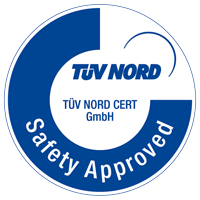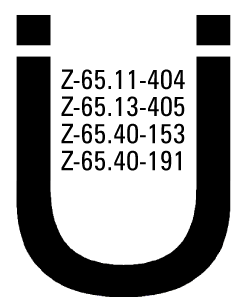Description
Ces interrupteurs à flotteur sont dotés d'un système de commutation sans mercure, composé d'un microrupteur et d'une bille qui actionne ce commutateur.
Données techniques
Données techniques
- Classe de protection EN60529
- IP 68
- Matériau Flotteur
- PP
- Câble
- TPK (PVC Basis), PVC Basis verstärkt, Polyurethan, Silikon, Teflon, Ethylen-Acrylat-Kautschuk
- Section du conducteur
- 3x 0,75 mm², Polyurethan 3x 0,5 mm²
- Température de fonctionnement TPK(V)
- AEM Kabel max.+ 60 °C
- Température de fonctionnement Câble PUR
- max.+ 70 °C
- Température de fonctionnement SIL, câble FEP
- max.+ 85 °C
- Pression de fonctionnement
- max. 1 bar Zylinder| max. 2 bar Kugel
- Système de commutation
- Mikroschalter
- Type de contact
- Wechsler, NO, NC
- Données de raccordement électrique, protection Ex
- siehe EG-Prüfbescheinigung TüV 09 ATEX 555342
- Charges inductives/capacitives
- Unbedingt Kontaktschutz vorsehen
- Marquage CE
- siehe Konformitätserklärung
- Poids
- ca. 200 g
Densité du matériau Ex-QFS-30
- Câble TPK(V)
- ρρ 0,85 g/cm³
- Câble PUR
- ρρ 0,95 g/cm³
- Câble SIL
- ρρ 0,90 g/cm³
- Câble FEP
- ρρ 0,95 g/cm³
- AEM Câble
- ρρ 0,90 g/cm³
Densité du matériau Ex-QFS-31
- Sphère
- ρρ 0,60 g/cm
Position de montage
- Ex-QFS-30
- waagerecht mit G1” Verschraubung, senkrecht mit Beschwerungsgewicht (Ex)
- Ex-QFS-31
- waagerecht mit Flansch ab DN 100 (PP)
Ex-QFS-3x configuration
Ex-QFS-3 - [ 1 ] - [ 2 ] - [ 3 ] - [ 4 ] - [ 5 ] - [ 6 ]
Autres informations sur les produits
Float switches are used for simple limit value acquisition. The float floats on the liquid surface through the higher density of the liquid, and acutates a switching operation when the float deviates from the horizontal position.
In the mercury-free float switches of the QFS… series microswitches are used which are operated by a weight or with a ball, or reed contacts operated by a magnet. Mercury switches can be replaced by the appropriate Design problem-free. Also switching hysteresis are possible.
The main field of application is for the acquisition of limit levels (overflow and dry-running protection). For min-max control of pumps float switch combinations with several float switches are suitable.
The float switches are fixed on a tube or with loading weights.Our float switches can be used both in water and in aggressive media. For this a suitable cable material has to be selected:
- Thermoplastic rubber cable (TPK) is useable for water, waste water and oily liquids, as well as slightly aggressive liquids.
- For oil-containing media a PTFE nozzle should be provided.
- Silicone (SIL) for washing liquor at high temperatures
- Teflon (FEP) for aggressive liquids (acids/alkalies)
- TPK cable with an ethylene-copolymer coating (AEM) for dilute acids and alkalies.














